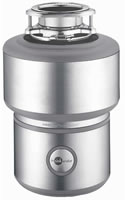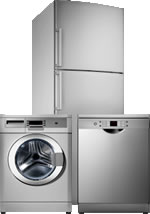Garbage Disposer Buying Tips

The garbage disposer is a wonderful tool for the kitchen to which most people give very little thought. At least until it doesn't do its job. Choosing the right garbage disposal will make it possible to never have to think about it again. So if you spend a little time now choosing the right model, you will likely never have a problem with the disposer until it is time for a new one.
Some people don't realize how much waste they could be sending down the drain, instead of filling up a trash can. A lot of food waste can be sent through the disposer instead of into the trash, which means less trips taking out the trash and less trash can odor. It can handle more than just the scraps from a dinner plate. Nearly all the food debris created during meal preparation can go down the drain, at least if you choose the right garbage disposer. Some things to avoid are very fibrous foods, like corn husks, and things that tend to clog the drain, like coffee grounds.
There are two basic varieties of garbage disposer, batch feed and continuous feed models. While the continuous feed style is the most common, the model you choose is really a matter of personal preference.
Continuous Feed Garbage Disposer
The continuous feed disposer model runs only switched on. The switch can be a regular wall switch or a counter top "air switch" (a non-electrical switch safe for wet environments). The disposer is operated by turning on the cold water, switching on the disposer and dropping suitable kitchen debris in the drain hole in the sink. After the debris has been thoroughly ground up, turn off the disposer and then a few seconds later turn off the water.
The main advantage of this disposer over a batch feed model is that you can continuously to feed in garbage until you are done.
The key disadvantage of this model is that it is more dangerous. It is possible to turn it on while reaching into the drain. There is also a risk of silverware, or other items, falling in while it is operating.
Batch Feed Garbage Disposer
A batch feed disposer operates very similarly as a continuous feed except there is no switch to operate it. Instead the disposer is switched on by placing the drain plug in place and turning it. You start by placing suitable kitchen waste into the disposer, turn on the cold water and install and turn the drain plug. When it has finished grinding , you stop the disposer by turning the drain plug the other way.
The key advantage is safety. The disposer operates only when the cap is in place. Also, it protects against something falling in while the disposer is operating. It also eliminates the need for a switch; although you may still need one as a way to easily cut power to the unit.
One disadvantage is that you must repeatedly open and load the disposer when you have a large batch of debris to dispose of. Another is that if you misplace the cap, you are unable to operate the disposer.
How Many Horsepower is Enough?
Residential garbage disposers range in power from 1/3 HP up to 1 HP. We recommend choosing a model with at least 1/2 HP to avoid most problems. However, a 3/4 HP model is an even better choice. Choose a 1 HP disposer to reliably chew threw large quantities of food waste and to get a thorough grind that produces particles that will flow easily down the drain.
Features and considerations for a new disposer:
- Choose a model with at least 3/4 HP for trouble free operation
- Low decibel noise levels
- some models designed to grind stringy material like corn husks
- Disposers take up valuable space under the sink. Choose a sink with a drain hole near the back to allow cabinet storage in front of the disposer.
- Extra deep sinks may restrict the size of disposer that can be installed. You must subtract the depth of the sink from the interior height of the cabinet to calculate the available space for a disposer. Leave extra space so you can access the reset button and manual crank under the disposer.
- Some disposers come with a cord and plug, others require hard-wire connections
- An air-switch can be placed any where and is non-electrical switch to operate the disposer. It can be installed through the countertop, cabinet or hidden behind the cabinet door.





